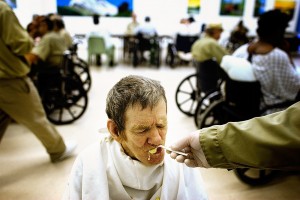Making Old and Sick People Pay is Just Cruel…
In the past couple of years, the idea that prison costs are unsustainable has gained purchase among policymakers. This has led to more of a willingness to discuss closing some prisons and that can only be a good thing.
I read a recent article in the Financial Times about the aging prison population in the U.S. I have written about this issue in the past. The FT article features the story of an 87 year old prisoner named Melville Atkinson who had already been incarcerated for 20 years. The article suggests that the number of elderly prisoners is poised to increase significantly:
The total number of elderly inmates is predicted to increase between four and seven times in the next 20 years, the fastest growing prisoner age group. Some academics estimate that one-third of the entire US prison population, which currently houses 1.6m people, will be more than 55 years old by 2030.
“It is the grey tsunami and it’s coming for us,” says Keith Davis, the warden at Deerfield.
This is stunning and very, very expensive. Elderly prisoners “like Mr Atkinson require specialist diets, medication and round-the-clock nursing – at an average cost of $70,000 a year, three times that of regular inmates, according to the Pew Center on the States, a think tank. Some cost as much as $1m a year.” I believe that it is a form of cruel and unusual punishment to keep 87 year olds locked behind bars no matter the crime. This should change. If we are not going to immediately abolish prisons, then we should push for age limits for imprisonment at the very least.
A related article points to a county in Pennsylvania that is trying to address its prisoner health care costs by instituting a co-payment requirement for doctor visits:
Fayette’s inmates are required to pay $10 to see a doctor. Inmates who want a second opinion pay a $20 co-pay. There is a $5 fee for prescription medications.
Brownfield said the fees are assessed on inmates with the means to pay. Care is provided at no charge to indigent inmates.
“We definitely see the number reducing of people asking to see a nurse or doctor,” Warden Brian Miller said. “If you have a headache and you want to talk to the nurse to get a Motrin, do you want to spend $5 for a couple of Motrin?”
It’s cheaper for inmates to get the pills at the commissary, Miller said.
“It comes down to a budgetary issue,” Miller said. “Every year, the inmate incarceration numbers are increasing, so anything you can do to recover some costs, we’re going to attempt to do.”
In Allegheny County, Dixon noted, many of the 2,500 to 2,700 inmates are indigent, with no means to make the payment. He said a previous administration considered the idea but rejected it.
“A past administration thought it would inhibit people from getting care, where if they didn’t have the money, they would have to decide whether to get care, or get something from the commissary,” Dixon said.
I think that the past administration had it right. Most prisoners were poor when they got to prison and certainly do not become rich while serving their time. I know that it costs a lot of money to provide health care for people so the solution should be to dramatically decrease the numbers of prisoners rather than to make prisoners pay for health care. It is worth reading the entire article to better understand the costs associated with providing health care to prisoners (particularly elderly ones). For example:
Fayette County pays Primecare Medical a monthly base fee of $45,413 to provide health care for inmates, according to the controller’s office. The county paid $31,984 monthly in 2005.
Pennsylvania, which houses about 51,200 inmates, spends an average of $4,000 per inmate annually for health care. For the fiscal year 2009-10, the state collected $414,262 in revenues from inmate co-pays.

